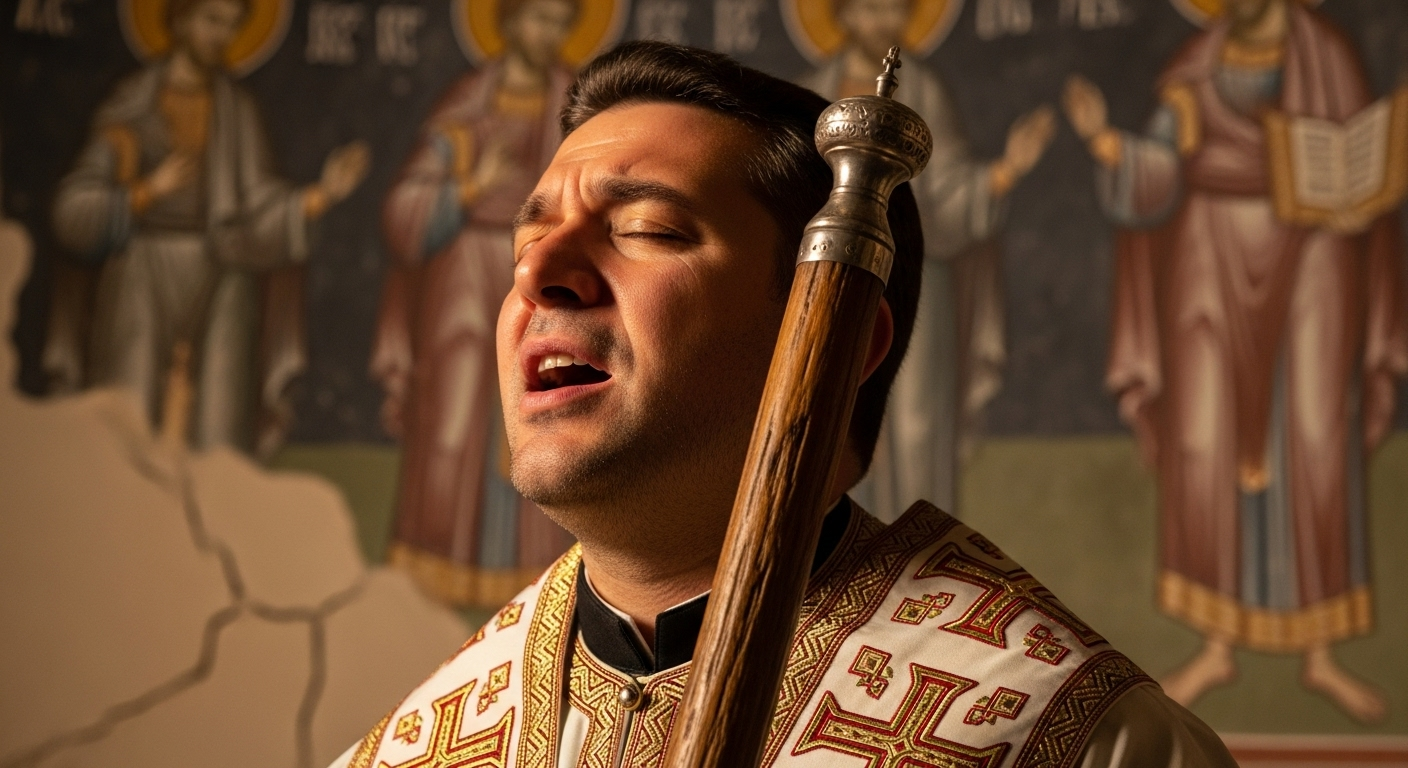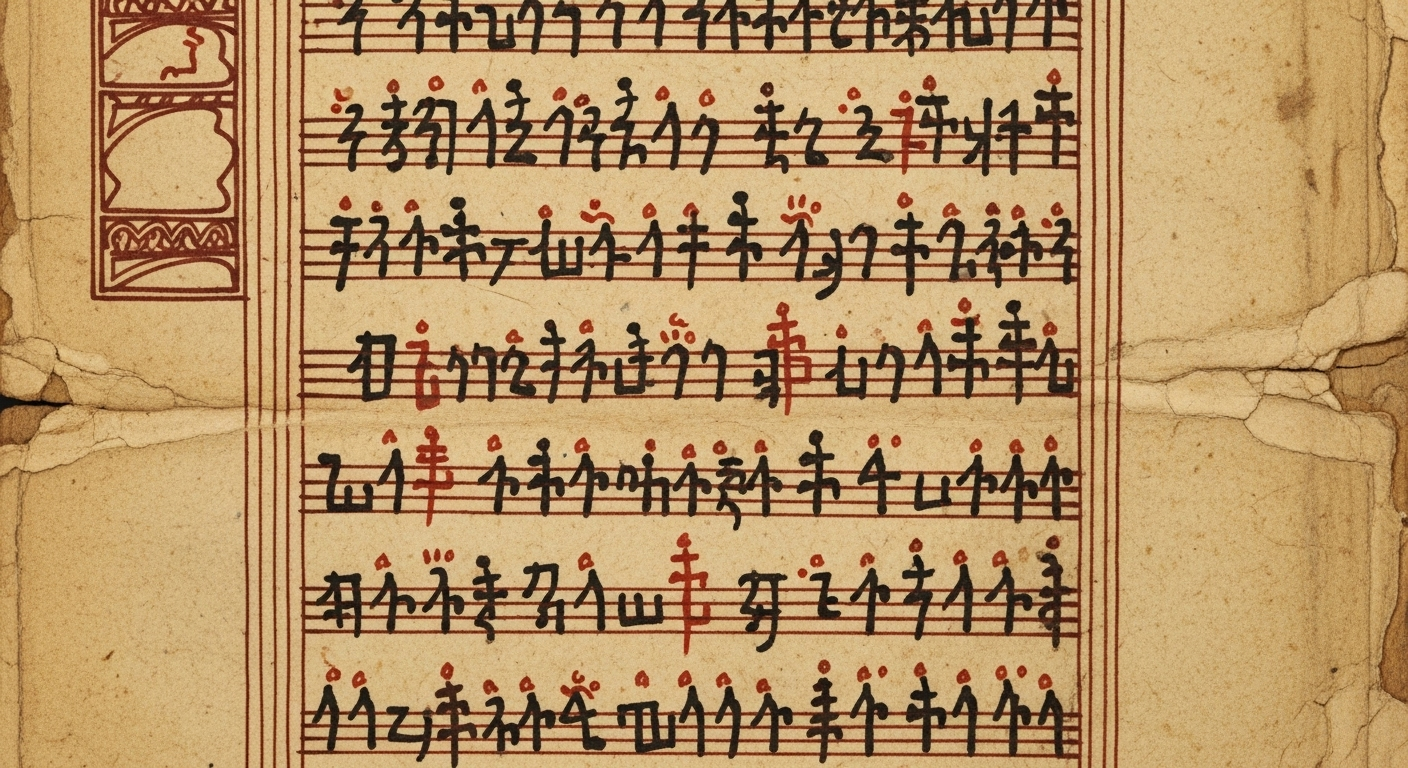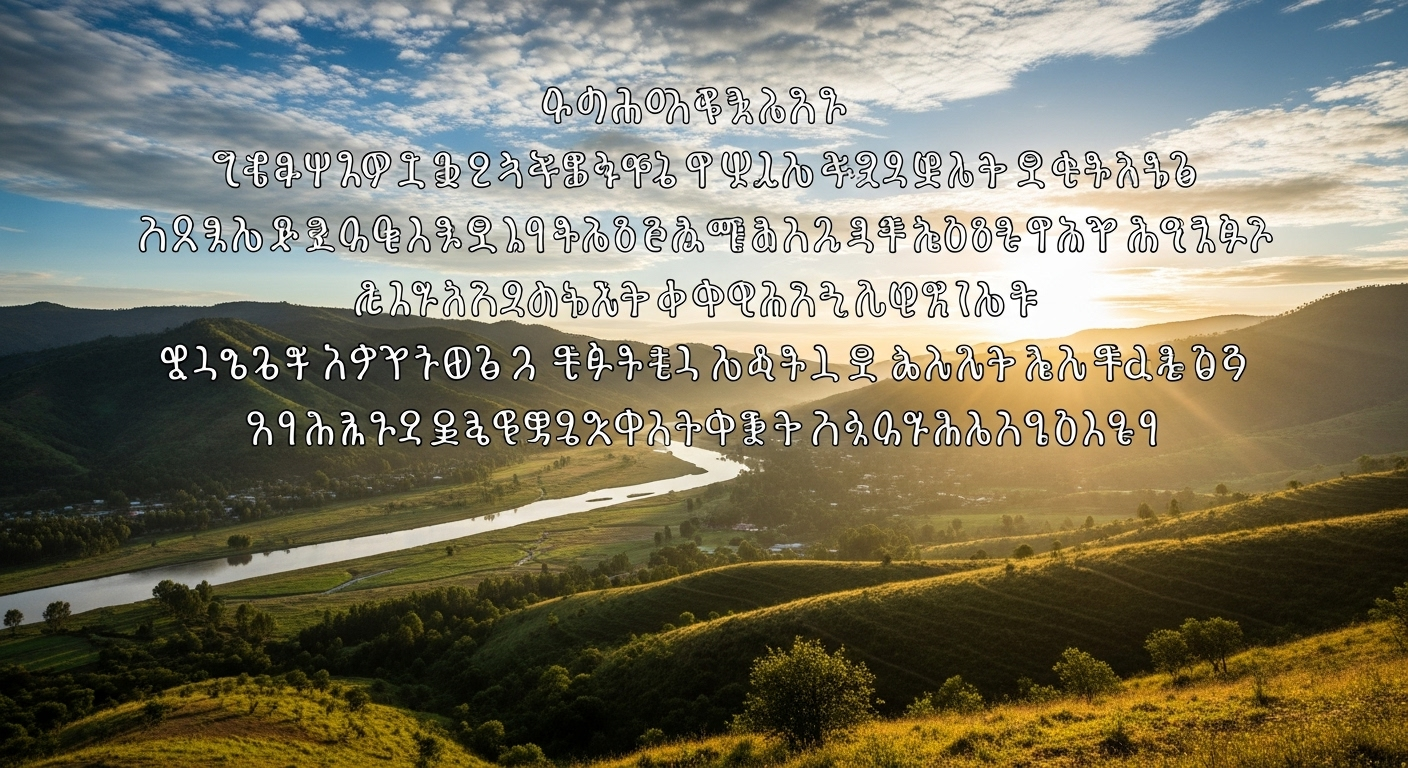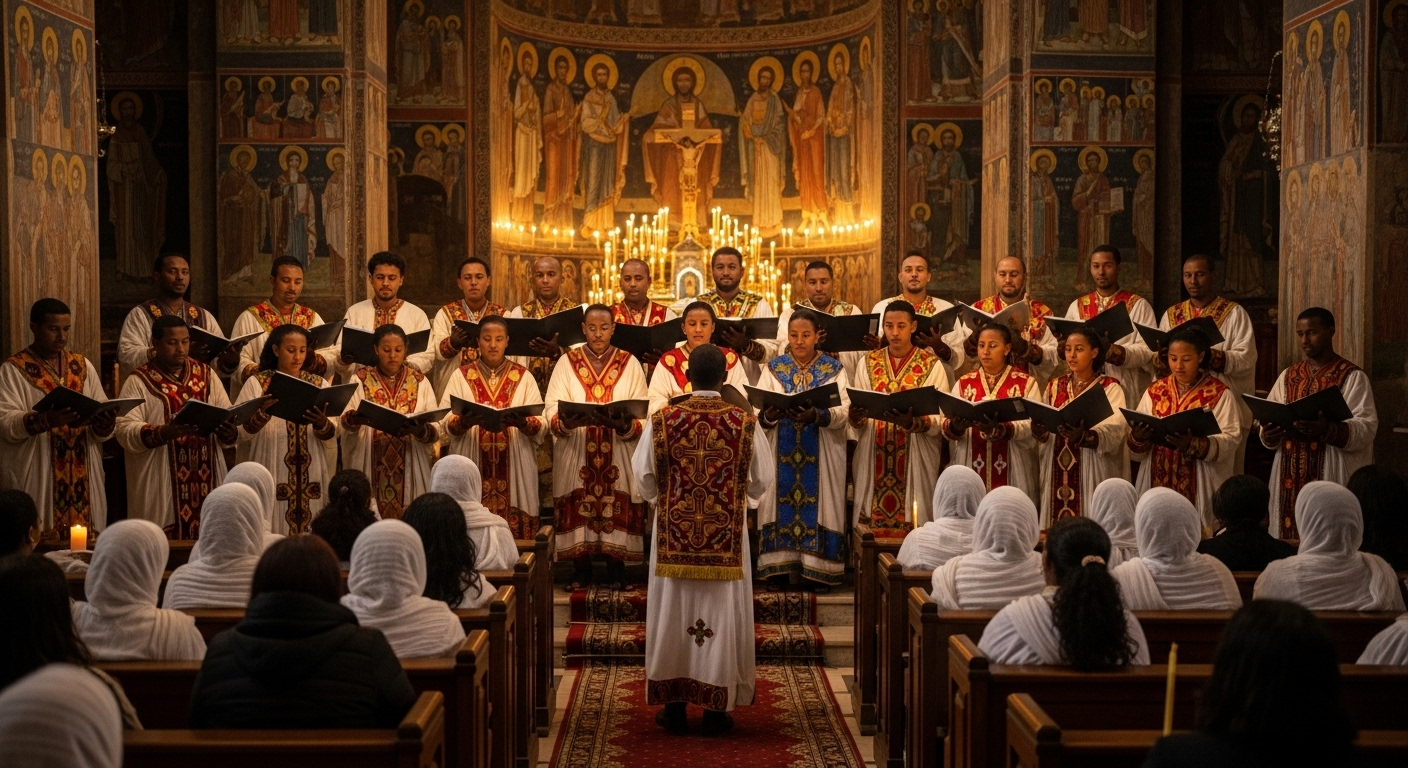Introduction
Mezmur (መዝሙር) simply means hymn or spiritual song in the Ethiopian Christian tradition. It’s a word full of faith and culture. In the Ethiopian Orthodox Tewahedo Church and many Protestant churches, mezmur plays a big part in prayer and worship. These songs are sung for praise God, share hopes, and bring people clos with their faith.
What Is Mezmur?
The word mezmur comes from Geʽez, the ancient church language in Ethiopia. It is a related word zema, which means chant or melody. In English, it’s close to the word psalm. Mezmur not only music it’s a prayer in melody. It connects people to their religion believe, their culture, and their community.

Historical Origins & Evolution of Mezmur
St. Yared and the Birth of Zema / Mezmur
The story of St. Yared is where it all began from. He lived in the 6th century and known as the father of Ethiopian church of music. Yared created a full system of chants called Zema. He introduced three main styles Geez, Ezil, and Araray which are still used in the church today.
His music became the base for all orthodox mezmur that followed. Every mezmur we hear today, old or new, carries the spirit of Yared’s work. He turned worship into song, and song into faith.
The Book of Deggua and the Church Tradition
The Book of Deggua (መጽሐፈ ድጓ) is a collection of hymns written by St. Yared. It guides the church on when and how to sing different songs during pray time. Each season, feast, and fasting day has its own mezmur in the Deggua. It’s the heart of Ethiopian Orthodox hymn tradition.
Many songs in today’s Orthodox mezmur collection come from this book. It keeps the same spirit alive through every generation.
Changes Over the Years – The Modern Mezmur
Over time, mezmur has changed in form and sound. What started as pure chant now includes instruments and recordings. People now sing in Amharic and also some local languages. You can find mezmur on YouTube, TV, and music apps, shared by singers from Ethiopia and from other regions.
New mezmur styles are appearing like New Orthodox Mezmur 2024 or Protestant Mezmur Hits. The message stays the same, but the way it’s shared keeps growing.

Types, Modes & Musical Structure of Mezmur
Chant Modes / Melodies (Geez, Ezil, Araray)
Every mezmur follows one of three main chant modes Geez, Ezil, and Araray. These were created by St. Yared, and they shape how hymns sound and feel.
-
Geez mode is calm and gentle. It’s used on regular church days.
-
Ezil mode is soft and sorrowful. It’s sung during fasting times or funerals.
-
Araray mode is joyful and bright. It’s used for major feasts and holy celebrations.
Each mode has a symbolic meaning too. Geez stands for the Father, Ezil for the Son, and Araray for the Holy Spirit. Some famous songs follow these patterns showing how deep and meaningful each style is.
Instrumentation & Accompaniment
Traditional mezmur music uses simple but powerful instruments. The main ones are the kebero (drum), tsanatsil (sistrum), and mequamia (staff used during chanting). These are used mainly in Orthodox mezmur during church services. In modern times, some churches started adding organs, keyboards, and guitars.
This has caused debate among church leaders some welcome it, others say it changes the holy nature of the music. The Ethiopian Orthodox Tewahedo Church Synod has even made decisions about how and when these instruments can be used. In Protestant mezmur, modern instruments are common. They use drums, keyboards, and guitars for easy to sing also it makes song beautiful.
Vocal Arrangement, Choirs & Performance Practice
Mezmur is not just sung it’s performed with heart and movement. In Orthodox churches, trained singers called däbtära lead the songs. They learn the chants in special training schools and pass the tradition down to new generations. Church choirs stand in special places during the service.
They sing in turns this is called antiphonal singing, where one side answers the other. Sometimes, body movement and gentle dance make the mezmur more expressive. In Protestant churches, choirs many time sing by men and women.

Branches / Variants of Mezmur: Orthodox vs Protestant
Ethiopian Orthodox (Tewahedo) Mezmur
Orthodox mezmur is deeply tied to church rituals and Zema chants. It follows the ancient melodies created by St. Yared. These songs are part of prayer, don’t use for entertainment. They are sung in Geʽez or Amharic, depending on the service.
Collections like Deggua preserve thousands of hymns used throughout the year. Some famous orthodox mezmur songs include “Aman Beaman”, “Meaza Senay”, and “Ewedishalehu Egziabher”. They carry history, prayer, and art in one voice.
Protestant Mezmur / Evangelical Hymns
Protestant mezmur has a different feel. It’s simple, direct, and usually sung in modern languages like Amharic, Oromo, or Tigrinya etc. These songs always share messages of love, hope, and salvation. They are more easier for everyone to sing together, both in church and home. Protestant mezmur often includes modern instruments like keyboards and guitars.
They are shared widely online through YouTube, mp3 downloads, and Telegram channels. Many believers listen daily, turning worship into a personal routine. Sometimes, Protestant and Orthodox songs influence each other. A few melodies and lyrics even overlap, showing how faith connects both traditions.
Hybrid & Contemporary Mezmur (New Mezmur, Fusion)
Today, a new style called “New Mezmur” is growing fast. These songs mix traditional chants with modern gospel sounds. You might hear electric guitar next to kebero drums, or ancient lyrics with new melodies. This fusion has created popular trends like “New Orthodox Mezmur 2024” and “Protestant Gospel Fusion”.
They are shared on music apps, social media, and live performances. Some traditional believers welcome this change, saying it helps reach young people. Others prefer to keep mezmur pure and ancient. Still, the mix shows how Ethiopian faith and music continue to grow together.
Famous Mezmur Songs, Composers & Collections
Classic / Timeless Orthodox Mezmur Songs
Some mezmur songs have been sung for centuries. They are known and loved by every generation. The earliest and most respected pieces come from St. Yared’s compositions. Popular classics include “Aman Beaman”, “Meaza Senay”, and “Egziabher Yimesgen”.
These songs stand out for their deep melody, poetic language, and spiritual power. Every note and rhythm carries peace, reflection, and faith. These timeless pieces are more than songs they are living prayers passed down through centuries.
Prominent Mezmur Artists & Gospel Singers
Modern times have brought many gifted mezmur artists and gospel singers. They keep this tradition alive while giving it a fresh voice. Some well-known names like Ephrem Tamiru, Mesenbet Gossaye, Moges Desta, Hirut Bekele, and Yohannes Afework. You’ll also find many rising singers on platforms like WikiMezmur and YouTube.
Each artist has their own style some follow Orthodox mezmur, while others perform Protestant gospel songs. Their albums, live performances, and recordings have inspired millions. Songs like “Enkuan Dehna Metah”, “Selam Le Egziabher”, and “Yene Tewled” are favorites in churches and homes alike. These artists prove that mezmur is not just old tradition it’s a growing and living art.
Collections, Albums & Archives (Orthodox & Protestant)
There are now many ways to explore and listen to mezmur. One popular album is “Ethiopian Orthodox Tewahedo Mezmur”, available on Spotify and other streaming platforms. You can also find old and new songs in Ethiopian orthodox mezmur collections, some dating back to the 2010s.
Websites like WikiMezmur, YouTube, and Telegram channels share thousands of recordings. Modern archives label songs as “new mezmur”, “new orthodox mezmur 2024”, or “Protestant gospel mezmur”.
This makes more easier for believers to find their favorite hymns anytime, anywhere. Many Ooline platforms like Facebook or YouTube are helping mezmur reach younger listeners and connect Ethiopian Christians all over the world.

Cultural, Spiritual & Social Significance
Role in Worship, Liturgy & Church Life
Mezmur plays a central role in Ethiopian church life. It is sung during Qurbana (Holy Communion), evening vigils, fasts, and festivals. Through this song, worship becomes deeper and more heartfelt. Each mezmur helps believers focus, pray, and feel united as one community.
It’s also a way to teach many hymns carry stories and messages from the Bible. So, mezmur is not only for singing. It’s a tool for spiritual growth and learning.
Cultural Identity & Heritage
Mezmur is part of Ethiopia’s Christian identity. It protects language, faith, and cultural values through music.But in the modern world throwing challenges. Young generations listen to new styles and sometimes forget traditional hymns.
Digital media helps but it also changes how people experience worship. Even with these changes, mezmur continues to connect generations and remind Ethiopians who they are.
Musicology & Research
Today, mezmur is also studied by researchers and musicians around the world. There are new projects like the “Zema Dataset” on arXiv, where scholars use data to study the structure of Ethiopian chants. Tools like machine learning and music analysis help to understand how mezmur melodies are built.
How to Listen, Learn, or Use Mezmur (Practical Guide)
Where to Find Mezmur (Audio, MP3, Streaming)
Finding mezmur today is easy. You can listen to it almost anywhere online or offline. Platforms like YouTube, Spotify, and Telegram channels have large collections of both Orthodox and Protestant mezmur. Search for playlists like “Ethiopian Orthodox Mezmur Collection” or “Protestant Mezmur Audio MP3 Download.”
How to Learn or Sing Mezmur (Tips for Choir & Beginners)
They define how mezmur is sung in different seasons and occasions. Joining a church choir is the best way to learn. There, experienced däbtära (church singers) can guide you through melekket the system of notation and rhythm used in Ethiopian chant. With practice and prayer, you can master the songs and share them in your community.
Using Mezmur in Personal & Church Life
Mezmur is not only for church. You can make it part of your daily worship too. Play your favorite songs during prayer, fasting, or family gatherings. It brings peace and focus to your spiritual life. If you want to share mezmur publicly like in events, recordings, or videos always check licensing and copyright rules.
Respect church traditions when using Orthodox mezmur in formal worship. Sharing mezmur responsibly helps preserve its sacred value and supports the artists who keep it alive.
Challenges, Debates & Future of Mezmur
Controversies & Criticism
Like many cultural traditions, mezmur faces debates. Some people worry that modern styles and instruments weaken its spiritual purity. The Ethiopian Orthodox Tewahedo Church has discussed this issue many times. Some leaders warn against too much modernization, calling it a “tehadeso” (reform) that risks changing church identity. Others believe that new mezmur keeps the message alive for younger generations. The main challenge is finding balance keeping faith strong while embracing new ways to praise.
Preservation Threats & Digital Risks
Old mezmur songs are slowly disappearing. Many were passed down by memory, not written or recorded. As older singers pass away, some hymns risk being forgotten forever. Digital media helps preserve them, but it also brings new problems.
Opportunities & Future Directions
Projects like digital transcription, machine learning analysis, and crowdsourced archives can save centuries of music for the next generation. Researchers are already using tools to study Zema patterns and document forgotten hymns.
Conclusion
Mezmur is more than just music. It continues to shape Ethiopian worship, identity, and community. Take time to listen. Share songs with friends and family. Support mezmur artists and help preserve this heritage for future generations.
For more, explore:
-
WikiMezmur.com for lyrics and translations
-
Spotify / YouTube for new and classic mezmur collections
-
Ethiopian Orthodox Mezmur MP3 archives for traditional recordings
May every mezmur you hear fill your heart with peace and faith.
FAQs
1. What is Mezmur?
Mezmur (መዝሙር) is a spiritual hymn in the Ethiopian Orthodox Church. It’s different from Zema, which is the chant system. Used in Qurbana, feast days, and daily worship.
2. What are the chant modes in Mezmur?
There are three main modes: Geez, Ezil, Araray.
-
Geez: calm, for regular days
-
Ezil: soft, for funerals and fasting
-
Araray: joyful, for major feasts
Each mode has symbolic meaning.
3. How is Protestant Mezmur different?
Protestant mezmur is simpler, uses modern instruments, and is sung in local languages.
Orthodox mezmur sticks to traditional instruments like kebero and tsanatsil.
4. Where can I listen to or download Mezmur?
You can find mezmur on YouTube, Spotify, Telegram, and WikiMezmur.
Search for “Orthodox Mezmur MP3” or “Protestant Mezmur audio download.”
5. How can I learn to sing Mezmur?
Learn basic chant modes, read Geʽez/Amharic lyrics, and join a church choir.
A däbtära teacher can guide you in notation and practice.

